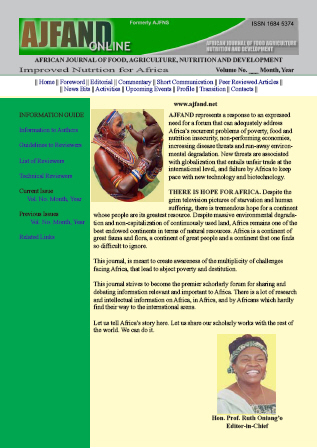
|
African Journal of Food, Agriculture, Nutrition and Development
Rural Outreach Program
ISSN: 1684-5358
EISSN: 1684-5358
Vol. 20, No. 3, 2020, pp. 15936-15953
|
 Bioline Code: nd20046
Bioline Code: nd20046
Full paper language: French
Document type: Research Article
Document available free of charge
|
|
|
African Journal of Food, Agriculture, Nutrition and Development, Vol. 20, No. 3, 2020, pp. 15936-15953
| fr |
Description agromorphologique et détermination du potentiel antioxydant des variétés sous-utilisées et nouvellement introduites de maïs, manioc, niébé et piment dans la région Maritime-Est du Togo
Agbodan, KML; Akpavi, S; Agbodan, KA; Kanda, M; Amegnaglo, KB; Adrou-Aledji, A; Batawila, K & Akpagana, K
Résumé
Au Togo, l’importance accordée aux variétés locales diminue, suite au changement graduel des itinéraires culturaux et des habitudes alimentaires. Ces variétés se trouvent menacées de disparition, au profit des variétés introduites. Pour une gestion durable de cette diversité locale, une caractérisation morphologique s’avère cruciale. Très peu d’étude ont porté, sur la caractérisation agromorphologique des variétés locales des principales cultures (maïs, manioc, niébé et piment) de la région Maritime-Est du Togo, ainsi que leurs valeurs nutritionnelles. Cette étude a pour objectif de faire une description agromorphologique et une détermination du degré de menace ainsi que du potentiel antioxydant des variétés locales très menacées et celles nouvellement introduites de maïs, manioc, niébé et piment. Pour atteindre ces objectifs, des enquêtes ethnobotaniques sont réalisées dans 25 villages, auprès de 126 personnes ressources. Les villages sont choisis afin d’avoir une répartition homogène et une couverture totale des ethnies. Quant aux personnes ressources, elles sont choisies sur accord des autorités locales ayant pris connaissance dudit questionnaire. Les variétés locales ont été différentiées grâce aux descripteurs agromorphologiques retenus à cet effet. Le degré de menace a été déterminé grâce à la matrice « variétés locales x localités ». L’analyse en composante principale a permis d’évaluer la structuration de la diversité locale sur la base des critères agromorphologiques. Les 44 variétés locales sont discriminées en quatre catégories. Les catégories des variétés locales très menacées ; menacées ; assez menacées et peu menacées contiennent respectivement quatre, six, dix-huit et seize variétés locales. Le test de réduction de la 2,2-diphényl-1-picrylhydrazyle est utilisé pour déterminer le potentiel antioxydant des extraits des variétés locales très menacées (Ayidzin, Adibolo, Katowali et Blikouhé) et celles introduites. Les variétés locales très menacées ont toutes, un potentiel antioxydant remarquable en comparaison aux variétés introduites. Le rapport est de l’ordre de 1,4 pour le piment ; 2,6 pour le maïs ; 5,2 pour le manioc et 6,4 pour le niébé. Ces données permettront une valorisation de cette agrobiodiversité en vue de leur sauvegarde. L’utilisation des variétés locales permettra ainsi de lutter contre la malnutrition et favorisera une gestion durable de ces ressources phytogénétiques. Un profond screening phytochimique s’avère nécessaire, afin d’identifier les molécules responsables des différences de potentiel antioxydant.
Mots Clés
Maïs; Manioc; Piment; Niébé; variétés locales; agrobiodiversité; antioxydant; agromorphologiques; 2;2-diphényl-1-picrylhydrazyle
|
| |
| en |
Agromorphological description and determination of the antioxidant potential of the underutilized and newly introduced varieties of maize cassava, cowpea and hot pepper in the Maritime-East region of Togo
Agbodan, KML; Akpavi, S; Agbodan, KA; Kanda, M; Amegnaglo, KB; Adrou-Aledji, A; Batawila, K & Akpagana, K
Abstract
In Togo, the importance given to local varieties of plants is decreasing due to the gradual change in cropping patterns and eating habits. These varieties are threatened with extinction for the benefit of introduced varieties. For sustainable management of these local varieties, a morphological characterization is necessary. Little research has been carried out on the agromorphological characterization of local varieties of the main crops (maize, cassava, cowpea and pepper) of the Maritime-East region of Togo, as well as their nutritional values. This study aims to undertake inventory of the local varieties, to determine their degree of threat, and to compare the antioxidant potential of the highly endangered local varieties and those introduced (corn, cassava, cowpeas and pepper). To achieve these objectives, ethnobotanical surveys were carried out in 25 villages, with 126 resource persons. The villages were chosen in order to have a homogeneous distribution and a total coverage of the ethnic groups. As for the resource persons, they were chosen by agreement of the local authorities who have taken note of the questionnaire. Local varieties have been differentiated by the agromorphological descriptors used for this purpose. The degree of extinction threat was determined by the "local varieties x localities" matrix. The principal component analysis made it possible to evaluate the structuring of local diversity on the basis of agromorphological criteria. The 44 local varieties are discriminated in four categories. The category of very threatened local varieties; threatened; fairly threatened and less threatened contain respectively four, six, eighteen and sixteen local varieties. The 2,2-diphenyl-1-picrylhydrazyl reduction test is used to determine the antioxidant potential of the highly endangered local varieties (Ayidzin, Adibolo, Katowali and Blikouhé) and those introduced. The highly endangered local varieties all have significant antioxidant potential compared to the introduced varieties. The ratio was as follows: 1.4 for pepper; 2.6 for maize; 5.2 for cassava and 6.4 for cowpea. These data will, thus, make possible the valorization of this agrobiodiversity with aims to safeguarding. The use of local varieties will thus help to combat malnutrition and promote sustainable management of these plant genetic resources. A deep phytochemical screening should be necessary to identify the molecules responsible for differences in antioxidant potential.
Keywords
Maize; cassava; pepper; cowpea; local varieties; agrobiodiversity; antioxidant; agromorphological; 2;2-diphenyl-1-picrylhydrazyl
|
| |
© Copyright 2020 - African Journal of Food, Agriculture, Nutrition and Development
Alternative site location: http://www.ajfand.net/
|
|
